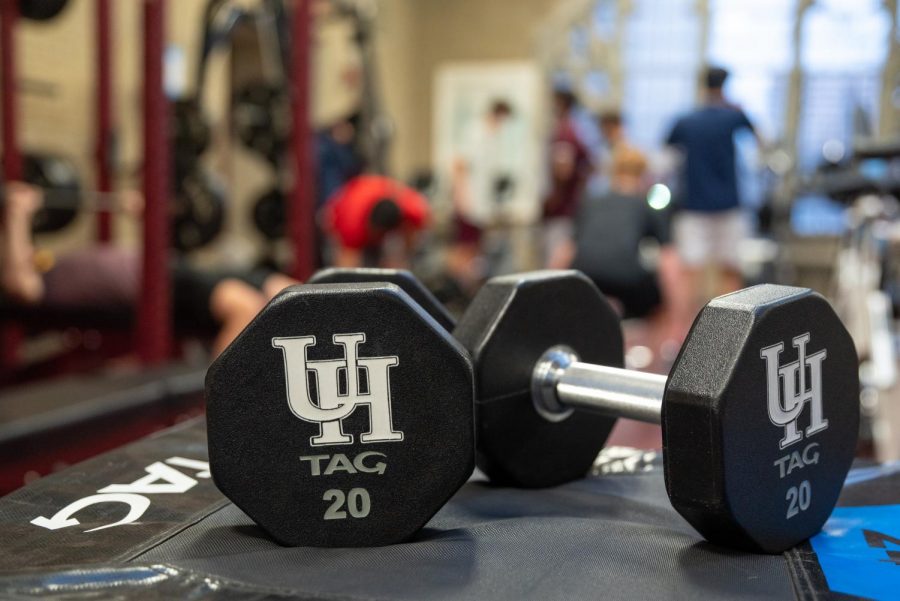Citing gender dynamic, some girls uncomfortable using fitness center
Some girls feel uncomfortable using the fitness center, saying it is male-dominated. P.E. teacher Luke Zavala, who monitors the fitness center after school, said he strives to create a welcoming environment.
December 13, 2021
When walking between Sunny and Kovler gymnasiums after school, it’s not uncommon to see a fitness center packed with U-High students working out. This year, however, a far less common sighting would be a fitness center packed with girls.
Though the fitness center coordinator emphasized that the school weight facility should be open to all, some U-High girls don’t feel comfortable entering the space because of the male-dominant culture it has cultivated, something that may be indicative of broader issues related to gender within school grounds.
Student A, who asked to have her name withheld, said she has been going to the school gym often this fall out of convenience.
“I go to the gym because the one near my house is usually very full and there are COVID precautions that kind of restrict many people in there,” Student A said. “It’s nice to go to the school one because it’s right there and I don’t have to drive anywhere else.”
Though the convenience of a gym to work out is a benefit, the space doesn’t come without its costs. While Student A enjoys the environment when working out, she has noticed that she is often one of the only female students, and the room is often occupied specifically by male sports teams.
“I noticed that it is extremely male dominated, and there are very few girls in the gym,” Student A said.
Student A expressed that this gender dynamic could easily discourage other U-High girls from entering the space.
“It feels kind of one-sided,” Student A said. “All-female gyms are becoming more popular now because of the uncomfortableness women typically feel in those spaces.”
Thomas O’Connor, a male student who often goes to the fitness center, says he could see how the gender dynamic might affect some girls.
“There is a strong supportive culture in the gym,” Thomas said, “but I can only imagine how discouraging it would be to feel like the odd one out.”
Despite a desire to work out in the gym’s convenient location, Student B, who asked to have her name withheld for fear of repercussions, chooses not to go there for exactly this reason, stressing that it is more common than most might think for girls to feel discomfort in male-dominated spaces.
“This is not just something that I feel,” Student B said. “I know none of my friends want to work at the school gym. They either have gym memberships, or don’t work out at all because they don’t feel comfortable.”
Luke Zavala, a P.E. teacher and coach who monitors the fitness center, expressed concern when hearing about this discomfort, adding that in past years the gender split has not been quite this drastic, as many girls sports teams have trained in the space.
“I’ve done workouts with the girls soccer team in the past, the girls basketball team in the past,” Mr. Zavala said. “This year, you know, I’m not sure why it hasn’t been as prevalent.”
One possible explanation, Mr. Zavala suggested, is that hesitancy to enter the gym space is a reflection of larger social issues that girls face in gyms around the world — even if they don’t directly take place within school grounds.
“Part of it has to do with the idea of misogyny,” Mr. Zavala said. “Unfortunately, there are people in the world that do treat women poorly and try to make them feel bad for a myriad of reasons.”
Mr. Zavala added that discomfort in gym spaces expands beyond gender to general issues with body image as well.
“I’ve done projects with classes where we look at the impact of body image — the idea of what society says a man should look like versus what society says a woman should look like,” Mr. Zavala said. “A high school fitness center, with all the concerns that all students have around body image, can be an intimidating place.”
Student B suggested that perhaps an alternative that would make girls feel more comfortable would be for sports teams to sign up for designated workout periods, so students could predict when the gym will be occupied.
“If there were other times when sports teams weren’t there, I think I would be more open and feel more comfortable working out, because nobody’s there to watch me lift weights or run on the treadmill,” Student B said. “And it’s also less overwhelming.”
Regardless of contrasting views, Mr. Zavala expressed that it is a genuine goal to make the space accessible for all, whether this be through getting the word out that the space is open, or being thoughtful in how students are encouraged to attend. But he said the hope is that the space can eventually fulfill its original purpose of accommodating all.
“The idea is that we’re creating a welcoming space for all people,” Mr. Zavala said, “to be able to come and feel safe.”




























































